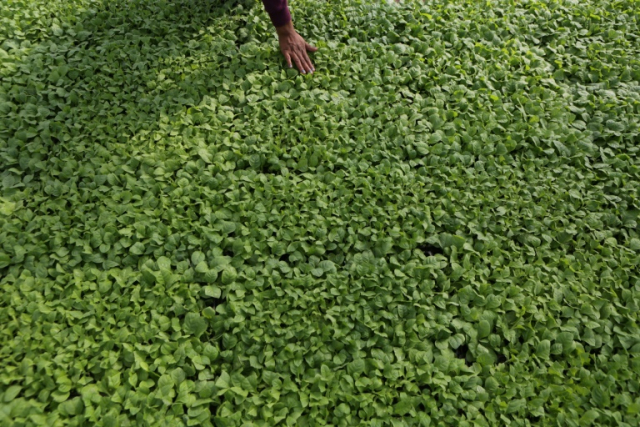
By altering a single gene, scientists coaxed tobacco plants, a model crop often used in experiments, to grow to near normal size with only 75 percent of the water they usually require. Image: Inti Ocon – AFP/File
Researchers on Tuesday unveiled a genetic modification that enables plants to use a quarter less water with scant reduction in yield.
By altering a single gene, scientists coaxed tobacco plants, a model crop often used in experiments, to grow to near normal size with only 75 percent of the water they usually require.
If major food crops respond the same way, they said, the first-of-its-kind genetic “hack” could help feed the growing population of an increasingly water-starved world.
“This is a major breakthrough,” said senior author Stephen Long, a professor at the Institute of plant biology at the University of Illinois.
“When water is limited, these modified plants will grow faster and yield more.”
The findings were reported in the journal Nature Communications.
Today, 1.2 billion people live in regions where water is scarce, and four billion — two-thirds of humanity — experience scarcity at least one month every year.
By 2030, the planet will face a 40 percent water deficit if global warming continues at its current pace, according to the UN World Water Development report.
Agriculture guzzles three-quarters of all groundwater withdrawals — 90 percent in poor countries.
“Making crop plants more water-use efficient is arguably the greatest challenge for current and future plant scientists,” said lead author Johannes Kromdijk, also from the University of Illinois.
Long and his team tweaked the gene that codes a protein, known as PsbS, crucial to photosynthesis, the process by which plants convert light into nutrients.
PsbS plays a key role in relaying information about the quantity of daylight, which triggers the opening and closing of microscopic leaf pores called stomata.
Some help from global warming
When stomata are open, plants can absorb the CO2 needed for photosynthesis.
At the same time, however, water also escapes into the air.
In the genetically engineered plants, increased levels of PsbS caused the tiny leaf pores to close earlier than they normally would, allowing the plant to retain more precious liquid.
Ironically, this gain in water storage is only made possible by global warming, which has increased the concentration of carbon dioxide in the atmosphere by about 25 percent since 1950.
In the experiments, the tobacco plants could take in enough CO2 — despite the stomata’s shortened work day — because of this higher concentration.
“Evolution has not kept pace with this rapid change, so scientists have given it a helping hand,” said Long.
Experts not involved in the research described the discovery as promising but called for tests on food-producing plants.
“As this photosynthesis gene is universal, there is potential for translating this research to crops,” commented Matthew Paul, a plant scientist at Rothamsted Research in Harpenden, England.
“However, the engineered plants produced less biomass,” something that would not sit well will farmers and agribusiness, he noted.
“A next challenge would be to see if the approach works in elite varieties of major crops without negatively impacting their ability to yield,” he told the Science Media Centre in Britain. NVG
RELATED STORIES:
Giant plant would boost rice harvests in China
Candy company, scientists team up to save chocolate from extinction by 2050